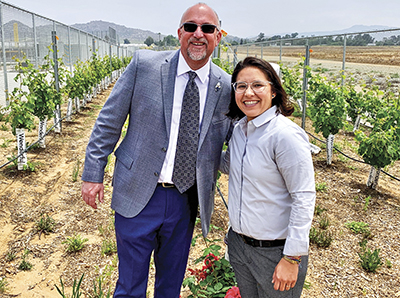Val Verde Reimagines Learning With Eyes on Students’ Futures
September 01, 2023
AASA Learning 2025 Lighthouse Demonstration System: Val Verde Unified School District

School gardens, a high school vineyard and STEAM maker spaces illustrate the power of reimagined learning spaces in California’s Val Verde Unified School District, where what students need to learn today to thrive tomorrow informs the work of professional learning communities and personalized learning initiatives.
“We’re shifting the narrative from accountability to individual and collective responsibility for student achievement,” says Michael McCormick, superintendent of the 20,000-student school district in Riverside County, where a quarter of the students learn English as a second language, 84 percent qualify for free- or reduced-price lunch and most college-bound graduates will be the first in their families to pursue higher education.
The results have been “incredible,” McCormick says, as he reports the graduation rate over the past eight years has increased to 94 percent (up from the 80s), while over the past 13 years, the college-going rate has hit 60 percent (up from the 30s). “Most important,” he adds, “our kids are engaged and happy, and our teachers have become liberated from some of the legacy accountability systems that we’ve all inherited.”
In his eighth year as superintendent and 26th year overall at Val Verde, McCormick says he was inspired by the 2021 release of the AASA Learning 2025 policy document. As a framework, he says, “it really served to unify a lot of the initiatives that we were working on in the district, dating back to 2015 and before.”
Now, as a designated Lighthouse System, Val Verde acknowledges flexibility and the 4C’s — communication, collaboration, creativity and critical thinking — for influencing its Portrait of a Graduate, which informs the skills, attitudes and learning needed for postsecondary studies and career pursuits.
With its Portrait of a Graduate predicated on developing future-ready learners who are flexible and adept at the 4C’s, in a school system where no student is marginalized, Val Verde depends on its data-driven Theory of Action to turn the portrait into practice.
From Grapes to Robotics
“We are heavily invested in the work around equity and access through a multitiered system of supports,” says Aimee Garcia, Val Verde’s director of K-12 education. The district’s bottom-up approach allows for site- and district-level learning teams to inform a curriculum council that shapes learning for future-ready success.
The district has been “co-constructing what the future of education looks like,” McCormick says, by analyzing data jointly with local labor partners.
Toward that end, antiquated computer labs have been reimagined into STEAM maker spaces at all grade levels, often with student input. Computer-aided design, along with 3D printing, video production, robotics and coding capabilities, “promote opportunities for students to work collaboratively in teams, use their critical thinking skills, solve problems creatively and then exhibit what they come up with,” McCormick says. Students show off their work at the annual Explorer Fair.
Gardens in all elementary and middle schools provide another reimagined learning space for STEAM studies, involving science, technology, engineering, the arts and math. Students grow food that is sold to the district’s food services, then served to students. One high school operates a multimillion-dollar greenhouse, which at full operating capacity will grow 600 heads of organic lettuce every week.
Students in the plant and soil sciences help to operate a high school vineyard in partnership with a nearby winery. Chemistry, biology, physics and engineering come into play, but there is also a focus in the arts. Students must learn how best to market wine sales and design bottle labels. “Our first harvest was 3.5 tons of cabernet sauvignon grapes, which now are being sold as wine,” McCormick says.
Pathways Galore
Val Verde’s students are not tracked according to whether they plan to go to college or not. “It’s both,” Garcia says. “We don’t want any door shut for our students.” As a result, Val Verde is rich in career and technical career pathways, with opportunities in many instances to earn industry certifications.
The district currently offers about 40 career technical pathways, including pharmacy assistant, welding, video production, drone certification, cybersecurity and graphics design. One of the high schools hosts a daycare center, where students receive training working with pre-K students.
Teachers also have opportunities for personalized learning and the chance to earn credential badges through an online, gamified learning platform. Instructional coaches at all schools work with teams on effective practices and pedagogy and provide demonstration lessons, Garcia adds.
As for the most daunting challenge that comes with systemic change, McCormick says that would be in resisting the status quo. “We’re always fighting that pull to return to what school once looked like,” he says. “That’s what keeps us up at night. It takes a lot of energy to keep change moving forward.”
Linda Chion is a freelance education writer in Lithia, Fla.
Author
Roster of Lighthouses
To read the full list of Lighthouse school systems being featured in this series and learn more about becoming a demonstration district, visit aasa.org/learning2025.
Advertisement
Advertisement
Advertisement
Advertisement




